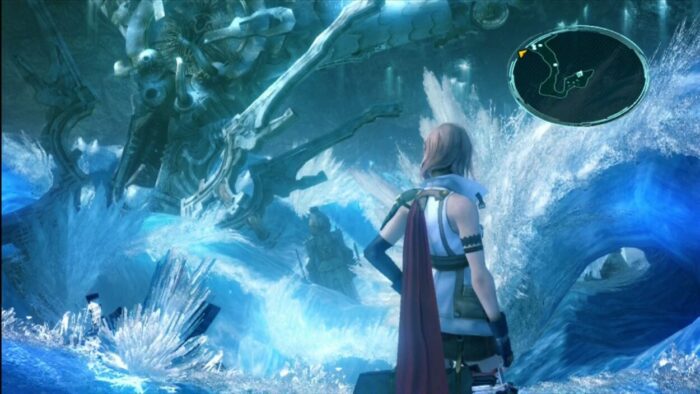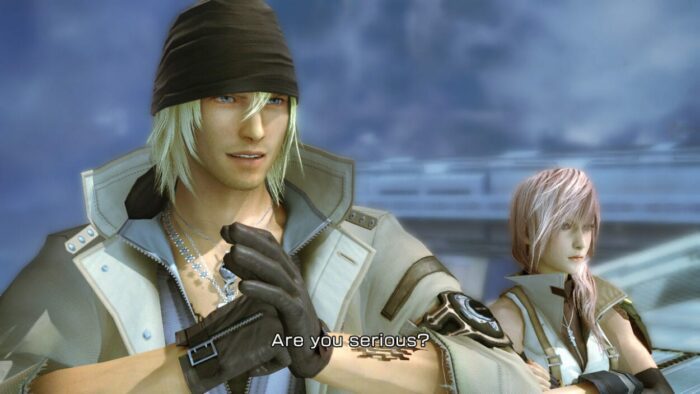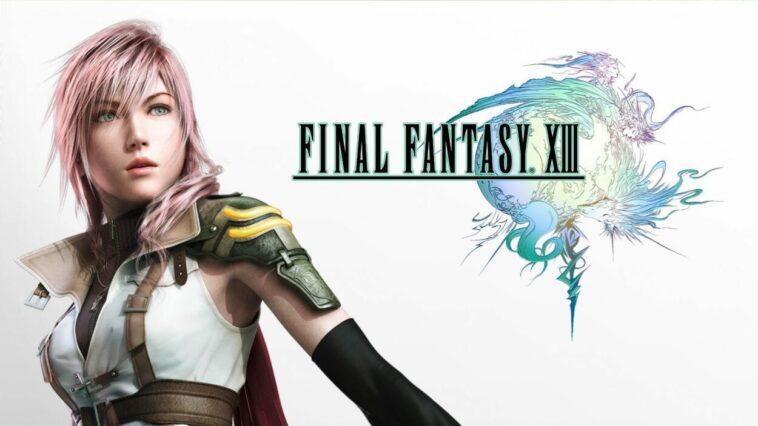The PS1 era of the Final Fantasy series saw Square Enix experiment with their storytelling gameplay. Although this trend arguably started with the sixth entry, it was popularized by the enormously well received PS1 games, and it’s a trend that has continued to this day. Each new entry means a brand new storyline, universe, world, characters, and (oftentimes) battle system. It’s exciting for fans when each new entry is so different from the last. It prevents stagnation, and helps keep the series relevant. The twelfth entry in the series did pretty well, of course, but fans were divided on its “single player MMORPG” feel it had going on. Sure, the world was big, but the story was hit or miss and some fans thought there was almost too much content to go through.
Enter Final Fantasy XIII which is, to this day, the most divisive entry in the series. It’s easy to see why, too. Not only did it fully embrace the sci-fi aesthetic previous entries had been playing with, but it changed so much of how the title played compared to past entries, and had an overly complex, somewhat-muddled story that contradicted itself at almost every turn. It more or less defines the phrase “love it or hate it,” and it’s still anyone’s guess as to whether or not it’s a good game.

At the time, the newest generation of consoles had just boomed onto the scene, and with new consoles means more powerful hardware. Square Enix took full advantage of this and delivered an end product that, regardless of how anyone might feel about it, looked fantastic for the time. Not only were technical elements strong (despite characters’ hands looking a little wonky), but the art design was simply top notch, providing a level of detail not seen in the series prior. Everything in it just looks cool, but this does lead to the first big dividing element of the game.
Several entries up to this point had placed a large emphasis on the story, with cut scenes that could last quite a long time. Final Fantasy X doubled down on this, with a largely linear story to play through and very long, sometimes cringe-worthy scenes. Final Fantasy XIII takes none of the lessons learned from X’s critics and doubled down on its worst tendencies. The story takes up a significant portion of the run time, with cut scenes sometimes stretching beyond the one hour mark depending on where you are. The majority of the game’s areas are basically linear hallways, with only a few areas a ways through the game opening up. And the story itself is filled to the brim with confusing Proper Nouns that require a rather extensive in-game encyclopedia to fully grasp.
See if you can follow me: Final Fantasy XIII follows a group of people swept up into a political and supernatural conflict in a place called Cocoon, a gigantic floating city that hangs above the world of Gran Pulse. Within Cocoon and Gran Pulse are beings known as fal’Cie, enigmatic beings with the power of Gods behind them. These fal’Cie choose people seemingly at random to fulfill some kind of unknown Focus. People with a Focus are known as l’Cie, and often have one of two fates. If they complete their Focus, they turn into a crystal, and are said to be in a period of stasis. If they can’t discover their Focus in time, or their emotional state is too conflicted, they instead turn into Cie’th, zombie-like beings with no consciousness of their own.
The main party are all brought into a conflict born of one of the fal’Cie being killed, and each of them are eventually branded as l’Cie. They need to figure out what their Focus is before they become Cie’th, and each person has a reason for fighting the will of the fal’Cie and political factions that populate Cocoon. Lightning is the leader, whose sister turned into a crystal upon fulfilling her Focus; Snow is a wannabe hero type who was engaged to Lightning’s sister; Vanille is a young woman with a mysterious burden that is at first unknown; Sazh is a pilot who wants to save his son from turning into a crystal or Cie’th; Hope seeks revenge on Snow, who he blames for his mother’s death; and Fang is the companion to Vanille, who wants to fulfill her Focus. All of them are given power by virtue of being l’Cie, and they all undergo their own personal arcs before gearing up to take on the game’s eventual major antagonist.

The game takes an ensemble approach to its storytelling, with the group oftentimes splitting up and forging off on their own before meeting up a good portion of the way through the game. And, like most elements of the game, there is a lot of good and bad with all of the characters. The most infamous one, Vanille, kind of has a reputation for being the Jar Jar Binks of this game, and it’s not difficult to see why. The voice actor speaks in a lighthearted, gratingly twee way, and she makes noises through her battles that are…uncomfortable, to say the least. Her overall chipper attitude and obnoxious voice acting makes it difficult to care about her. But her backstory, where it’s revealed her Focus used to be to destroy Cocoon by wielding Ragnarok, has a lot of potential to be interesting, but the execution of the character completely puts people off, and understandably so.
Sazh is another character that is sporadically interesting but suffers in his execution. He is commonly criticized as being the token black/comic relief character, but he undergoes some huge changes as well, and has some emotionally intense and dark moments that, again, could have made him one of the standout characters. The problem is that after he undergoes his arc, about two thirds of the way through the game, he ceases to be interesting and does, indeed, gets relegated to little more than the wise cracking pilot. Other characters fare the same way; Hope learns a lot about the nature of revenge, but you have to put up with a lot of whining from him, and it almost becomes too much; meanwhile, Snow has a great voice actor in the form of Troy Baker, and his optimism could be viewed as the group’s heart and soul if he didn’t have a hero complex he vocalizes at every single chance he gets.
And if you’re able to get past the perplexing amount of proper nouns and confusing world building, the story does contain a lot of interesting themes, including the classic JRPG trope of defying one’s fate, but there’s a LOT of reading required in order to fully grasp what’s going on. Simply taking the story in through the cut scenes reveals a very pretty but quite confusing narrative with a whole lot of weird words to learn.
The heavy scripting also means the game takes forever to feel like a proper JRPG. The first half of the game sees the player taking control of smaller parties of various mixes of the main cast, and it doesn’t let the battle system show off what it’s capable of until more than halfway through the game. A major plot point is that each character can summon their own Eidolin, including series staples like Shiva and Ifrit, and yes all of them look glorious. But controlling only one or two characters instead of the full three and not having access to all of the system’s options after 15 or even 20 hours feels immensely frustrating in its limitation.

Once the game lets you off the leash and, you know, play the damn thing, the battling does come into its own, although it does carry its own set of issues as well. ATB returns in this entry, and the new focus is on Staggering enemies by exploiting their weaknesses and following up with powerful attack combos in order to take away large chunks of their health. Meanwhile, you can customize what are called Paradigms, which drastically affect the way your party plays. At first each character has a predetermined role, with the six classes being Commando (fighter), Ravager (think Black Mages), Medic (White Mages), Sentinel (the tank), Saboteur (which specializes in inflicting status ailments on enemies), and Synergists (which specialize in providing buffs to the party). A Paradigm sets up the set of classes for a given team. It requires some clunky menu navigation, but you can set up Paradigms ahead of time to prepare for any given situation. You can create one that’s all-out attack or solely dedicated on healing. Or maybe you want one that is all about inflicting status ailments. The options are rather extensive once they become available to you.
The biggest issue with battling, apart from the fact that the game tries to present the illusion of choice with its grid based leveling (in reality, there’s only one path to follow for each grid), is that you can get away with auto battling for much of the run time. With auto battle, the game will automatically choose whatever the best course of action is. If you have a Medic on your team, they’ll likely cast spells when the team’s HP is low. Commandos will press the attack, and Ravagers will cycle through magic types until you find the proper element they’re weak to. Sure, you can go through and navigate the menu in order to choose what actions to take, but the ATB bar doesn’t stop filling, meaning being indecisive can actually set you back quite a bit, particularly during one of the game’s many boss fights.
Like building your party, it isn’t until very late in the game that strategy becomes a major deciding factor, with the final few chapters containing a lot of very difficult boss encounters that require proper preparation and thinking on your feet. By that point, players will have either given up on the game (after all, taking 20 or so hours to properly “be good” is too much commitment for many) or they’ll have decided that they’re along for the ride and enjoy the story enough to push through to the end.
Final Fantasy XIII is very much a product of its time, the big, arguably bloated, questionably designed JRPG answer to all of the linear action games that defined AAA development of the early 2010s. Whether or not that’s a good thing is largely left up to the individual player. For me, I think it’s a great looking game with lots of nice moments buried underneath too much weak design and convoluted storytelling. For every good design idea or story beat, there’s at least one bad one just waiting around the corner.

Square Enix clearly wanted it to be the next Final Fantasy VII in terms of multimedia appeal, and apparently it succeeded in that. There were not one, but two direct sequels to this entry, XIII-2 and Lightning Returns. From what I’ve seen, the former actually did take on the more exploratory structure of previous entries and has a following because of that, and the latter employs a weird Majora’s Mask-esque time limit where the player only has a certain amount of time per playthrough to complete objectives. I haven’t seen many people say they enjoy Lightning Returns at all. But even beyond the two direct sequels, Final Fantasy XIII had numerous pieces of associated media, including art books and CDs with the game’s soundtrack, and for some ungodly reason Louis Vuitton even teamed up with Square Enix to have Lightning model their products. Don’t ask me why this happened, because if I was smart enough to answer that question, I’d probably be a billionaire.
At the end of the day, Final Fantasy XIII remains an extremely popular but ridiculously divisive entry in the beloved franchise. It was, for better and worse, the next step for the series. It fully embraced its sci-fi aesthetic and went a long way toward establishing a unique universe Square Enix could capitalize on a la Final Fantasy VII. I think that it’s too dismissive to say that it’s an outright awful game, but to say it’s a great one is just as problematic. It is what it is, and Square Enix would later take all the critiques of Final Fantasy XIII and go almost too far in the other direction with its next big singleplayer release. At the end of the day, it might not be the best or worst in the franchise, but it’s one of the most fascinating.

